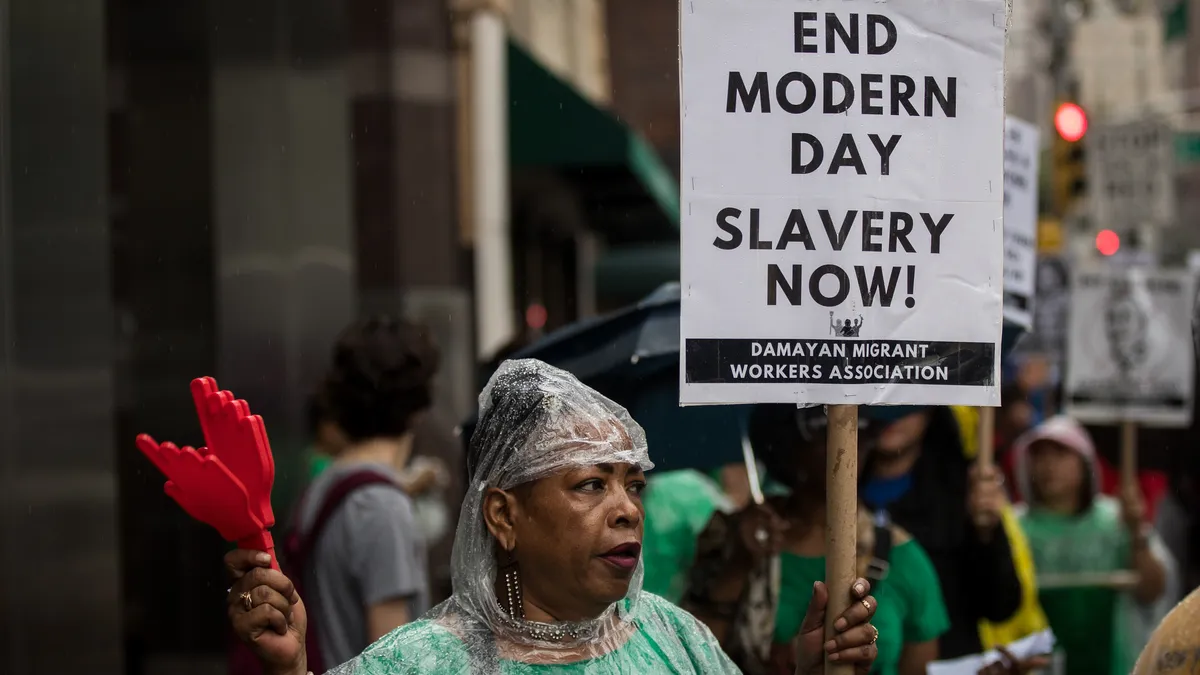Forced labor is among the most complicated, persistent challenges in building sustainable supply chains.
Just half of sustainable procurement leaders said they feel they are making effective progress to address the risk of modern slavery in the supply chain, according to a recent Gartner survey. This is even though 71% described the risk as important or highly important.
“It is difficult because it is everywhere,” said Laura Rainier, a senior research director on Gartner’s sustainability team and one of the authors of a report about the firm’s survey findings and how companies can better address modern slavery risks. The consulting and research firm’s Sustainable Procurement Pulse Survey included 104 respondents who led or participated in a sustainable procurement initiative in the past two years.
Some 50 million people live in forced labor, according to human rights group Walk Free’s latest Global Slavery Index. China, India, Indonesia, Turkey and the U.S., among many other countries, all have large numbers of people living in modern slavery, according to Walk Free. And the U.S. is “by far” the biggest importer of at-risk goods.
Even straightforward risks like state-sponsored forced labor, such as that of the Uyghur people in China — which is the subject of import laws in the U.S. — can be difficult to root out from a supply chain, Rainier noted.
Yet more challenging can be identifying links in the supply chain to debt bondage and forced labor tied to human trafficking, which can happen under even more deeply obscured conditions.
On the whole, respondents in Gartner’s survey pointed to the vastness and complexity of supply chains as key barriers in making progress on modern slavery, per the report. That makes getting data and visibility a foundational step in addressing the risk.
“There’s been as much focus just on understanding who is in my supply chain as what’s going on there,” Rainier said.
Publicly available data can give companies a general map of the commodities and countries with the highest risks. Some risk management solutions can scrape news and other sources for emerging risks. Going deeper, companies can look at recruitment corridors where migrants are typically come and go, and where forced labor risks can be higher, Rainier noted.
Deeper visibility means collecting data such as locations of manufacturers and suppliers as well as nearby distribution hubs and nodes, according to the Gartner team. As Rainier explained, looking at this data through the tiers of a company’s suppliers can give a deeper picture of exposure to problematic areas and be cross-referenced with lists of specific entities tied to forced labor risk.
Suppliers aren’t always so willing to offer up information on their own supply chains, though. “There are definitely industries where there’s resistance to sharing the data,” Rainer said, noting that some vendors may fear a buyer will go around them to their suppliers or use data hinting at their cost structures to squeeze suppliers on price.
“You can have the best tech solution in the world, but you have to have trust with your suppliers to mitigate [modern slavery] risks,” Rainier said.
Even with good data and analysis capabilities, there’s work to be done, including building capabilities with suppliers to manage issues around modern slavery with training and goals, which again requires a deep partnership with suppliers.
Assessment and remedial processes for suppliers are also critical, Rainier said.
At the same time, she pointed to “audit fatigue” and challenges in rooting out problems in the traditional social audit. Stronger audits, she added, focus on workers, and auditors ideally know the languages of migrant workers at a supplier so they can interview them directly or have some way of communicating with them.















